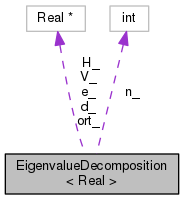#include <jama-eig.h>

Public Member Functions | |
| EigenvalueDecomposition (const MatrixBase< Real > &A) | |
| ~EigenvalueDecomposition () | |
| void | GetV (MatrixBase< Real > *V_out) |
| void | GetRealEigenvalues (VectorBase< Real > *r_out) |
| void | GetImagEigenvalues (VectorBase< Real > *i_out) |
Private Member Functions | |
| Real & | H (int r, int c) |
| Real & | V (int r, int c) |
| void | Hqr2 () |
| void | Tred2 () |
| void | Tql2 () |
| void | Orthes () |
Static Private Member Functions | |
| static void | cdiv (Real xr, Real xi, Real yr, Real yi, Real *cdivr, Real *cdivi) |
Private Attributes | |
| int | n_ |
| Real * | d_ |
| Real * | e_ |
| Real * | V_ |
| Real * | H_ |
| Real * | ort_ |
Definition at line 39 of file jama-eig.h.
| EigenvalueDecomposition | ( | const MatrixBase< Real > & | A | ) |
Definition at line 876 of file jama-eig.h.
References EigenvalueDecomposition< Real >::d_, EigenvalueDecomposition< Real >::e_, EigenvalueDecomposition< Real >::H(), EigenvalueDecomposition< Real >::H_, EigenvalueDecomposition< Real >::Hqr2(), rnnlm::i, MatrixBase< Real >::IsSymmetric(), rnnlm::j, KALDI_ASSERT, EigenvalueDecomposition< Real >::n_, MatrixBase< Real >::NumCols(), MatrixBase< Real >::NumRows(), EigenvalueDecomposition< Real >::ort_, EigenvalueDecomposition< Real >::Orthes(), EigenvalueDecomposition< Real >::Tql2(), EigenvalueDecomposition< Real >::Tred2(), EigenvalueDecomposition< Real >::V(), and EigenvalueDecomposition< Real >::V_.
Definition at line 911 of file jama-eig.h.
References EigenvalueDecomposition< Real >::d_, EigenvalueDecomposition< Real >::e_, EigenvalueDecomposition< Real >::H_, EigenvalueDecomposition< Real >::ort_, and EigenvalueDecomposition< Real >::V_.
|
inlinestaticprivate |
Definition at line 73 of file jama-eig.h.
References rnnlm::d, and EigenvalueDecomposition< Real >::Hqr2().
Referenced by EigenvalueDecomposition< Real >::Hqr2().
|
inline |
Definition at line 61 of file jama-eig.h.
References VectorBase< Real >::Dim(), EigenvalueDecomposition< Real >::e_, rnnlm::i, KALDI_ASSERT, and EigenvalueDecomposition< Real >::n_.
Referenced by MatrixBase< float >::Eig().
|
inline |
Definition at line 55 of file jama-eig.h.
References EigenvalueDecomposition< Real >::d_, VectorBase< Real >::Dim(), rnnlm::i, KALDI_ASSERT, and EigenvalueDecomposition< Real >::n_.
Referenced by MatrixBase< float >::Eig().
|
inline |
Definition at line 47 of file jama-eig.h.
References rnnlm::i, rnnlm::j, KALDI_ASSERT, EigenvalueDecomposition< Real >::n_, MatrixBase< Real >::NumCols(), MatrixBase< Real >::NumRows(), and EigenvalueDecomposition< Real >::V().
Referenced by MatrixBase< float >::Eig().
|
inlineprivate |
Definition at line 69 of file jama-eig.h.
References EigenvalueDecomposition< Real >::H_, and EigenvalueDecomposition< Real >::n_.
Referenced by EigenvalueDecomposition< Real >::EigenvalueDecomposition(), EigenvalueDecomposition< Real >::Hqr2(), and EigenvalueDecomposition< Real >::Orthes().
|
private |
Definition at line 436 of file jama-eig.h.
References EigenvalueDecomposition< Real >::cdiv(), EigenvalueDecomposition< Real >::d_, EigenvalueDecomposition< Real >::e_, EigenvalueDecomposition< Real >::H(), rnnlm::i, rnnlm::j, rnnlm::n, EigenvalueDecomposition< Real >::n_, and EigenvalueDecomposition< Real >::V().
Referenced by EigenvalueDecomposition< Real >::cdiv(), and EigenvalueDecomposition< Real >::EigenvalueDecomposition().
|
private |
Definition at line 345 of file jama-eig.h.
References EigenvalueDecomposition< Real >::H(), rnnlm::i, rnnlm::j, EigenvalueDecomposition< Real >::n_, EigenvalueDecomposition< Real >::ort_, and EigenvalueDecomposition< Real >::V().
Referenced by EigenvalueDecomposition< Real >::EigenvalueDecomposition().
|
private |
Definition at line 227 of file jama-eig.h.
References EigenvalueDecomposition< Real >::d_, EigenvalueDecomposition< Real >::e_, kaldi::Hypot(), rnnlm::i, rnnlm::j, EigenvalueDecomposition< Real >::n_, and EigenvalueDecomposition< Real >::V().
Referenced by EigenvalueDecomposition< Real >::EigenvalueDecomposition().
|
private |
Definition at line 113 of file jama-eig.h.
References EigenvalueDecomposition< Real >::d_, EigenvalueDecomposition< Real >::e_, rnnlm::i, rnnlm::j, EigenvalueDecomposition< Real >::n_, and EigenvalueDecomposition< Real >::V().
Referenced by EigenvalueDecomposition< Real >::EigenvalueDecomposition().
|
inlineprivate |
Definition at line 70 of file jama-eig.h.
References EigenvalueDecomposition< Real >::n_, and EigenvalueDecomposition< Real >::V_.
Referenced by EigenvalueDecomposition< Real >::EigenvalueDecomposition(), EigenvalueDecomposition< Real >::GetV(), EigenvalueDecomposition< Real >::Hqr2(), EigenvalueDecomposition< Real >::Orthes(), EigenvalueDecomposition< Real >::Tql2(), and EigenvalueDecomposition< Real >::Tred2().
|
private |
Definition at line 94 of file jama-eig.h.
Referenced by EigenvalueDecomposition< Real >::EigenvalueDecomposition(), EigenvalueDecomposition< Real >::GetRealEigenvalues(), EigenvalueDecomposition< Real >::Hqr2(), EigenvalueDecomposition< Real >::Tql2(), EigenvalueDecomposition< Real >::Tred2(), and EigenvalueDecomposition< Real >::~EigenvalueDecomposition().
|
private |
Definition at line 94 of file jama-eig.h.
Referenced by EigenvalueDecomposition< Real >::EigenvalueDecomposition(), EigenvalueDecomposition< Real >::GetImagEigenvalues(), EigenvalueDecomposition< Real >::Hqr2(), EigenvalueDecomposition< Real >::Tql2(), EigenvalueDecomposition< Real >::Tred2(), and EigenvalueDecomposition< Real >::~EigenvalueDecomposition().
|
private |
Definition at line 96 of file jama-eig.h.
Referenced by EigenvalueDecomposition< Real >::EigenvalueDecomposition(), EigenvalueDecomposition< Real >::H(), and EigenvalueDecomposition< Real >::~EigenvalueDecomposition().
|
private |
Definition at line 92 of file jama-eig.h.
Referenced by EigenvalueDecomposition< Real >::EigenvalueDecomposition(), EigenvalueDecomposition< Real >::GetImagEigenvalues(), EigenvalueDecomposition< Real >::GetRealEigenvalues(), EigenvalueDecomposition< Real >::GetV(), EigenvalueDecomposition< Real >::H(), EigenvalueDecomposition< Real >::Hqr2(), EigenvalueDecomposition< Real >::Orthes(), EigenvalueDecomposition< Real >::Tql2(), EigenvalueDecomposition< Real >::Tred2(), and EigenvalueDecomposition< Real >::V().
|
private |
Definition at line 97 of file jama-eig.h.
Referenced by EigenvalueDecomposition< Real >::EigenvalueDecomposition(), EigenvalueDecomposition< Real >::Orthes(), and EigenvalueDecomposition< Real >::~EigenvalueDecomposition().
|
private |
Definition at line 95 of file jama-eig.h.
Referenced by EigenvalueDecomposition< Real >::EigenvalueDecomposition(), EigenvalueDecomposition< Real >::V(), and EigenvalueDecomposition< Real >::~EigenvalueDecomposition().